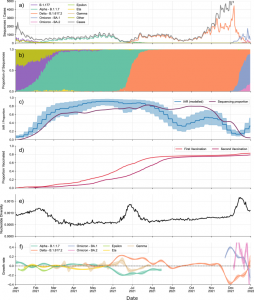Our newest faculty hire Jonas L. Juul is already making a splash. He published a big multi-author paper in Nature Communications: High-resolution epidemiological landscape from ~290,000 SARS-CoV-2 genomes from Denmark, by M.P. Khurana et al
We are happy that with Jonas, who was part of the Statens Serum Institut’s expert group on mathematical modeling of COVID-19 during the reopening of Denmark in the spring and summer of 2020, we have gained a solid footing in medical applications of data/network science.

We examined the drivers of molecular evolution and spread of 291,791 SARS-CoV-2 genomes from Denmark in 2021. With a sequencing rate consistently exceeding 60%, and up to 80% of PCR-positive samples between March and November, the viral genome set is broadly whole-epidemic representative. We identify a consistent rise in viral diversity over time, with notable spikes upon the importation of novel variants (e.g., Delta and Omicron). By linking genomic data with rich individual-level demographic data from national registers, we find that individuals aged < 15 and > 75 years had a lower contribution to molecular change (i.e., branch lengths) compared to other age groups, but similar molecular evolutionary rates, suggesting a lower likelihood of introducing novel variants. Similarly, we find greater molecular change among vaccinated individuals, suggestive of immune evasion. We also observe evidence of transmission in rural areas to follow predictable diffusion processes. Conversely, urban areas are expectedly more complex due to their high mobility, emphasising the role of population structure in driving virus spread. Our analyses highlight the added value of integrating genomic data with detailed demographic and spatial information, particularly in the absence of structured infection surveys.
